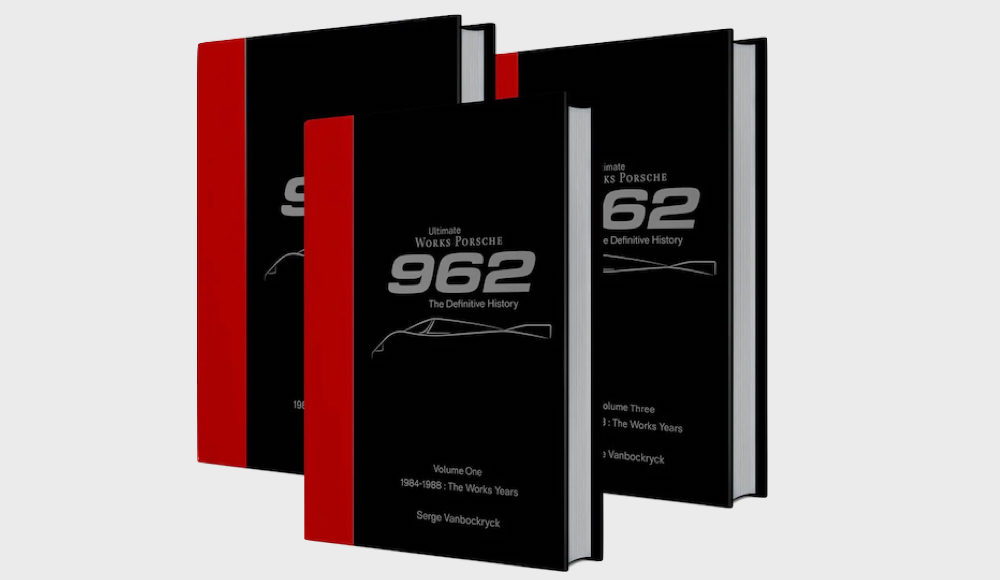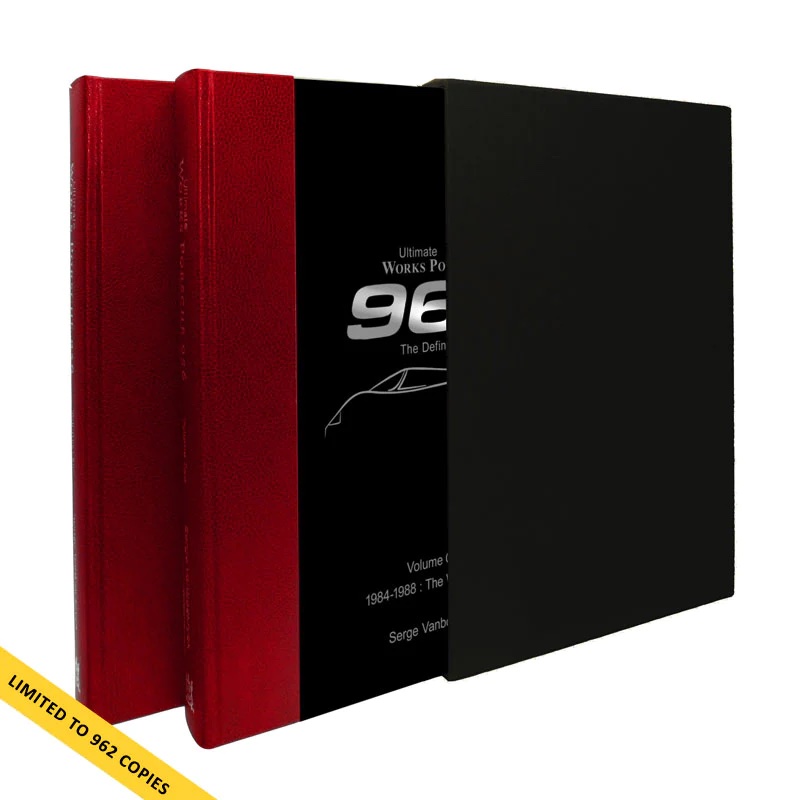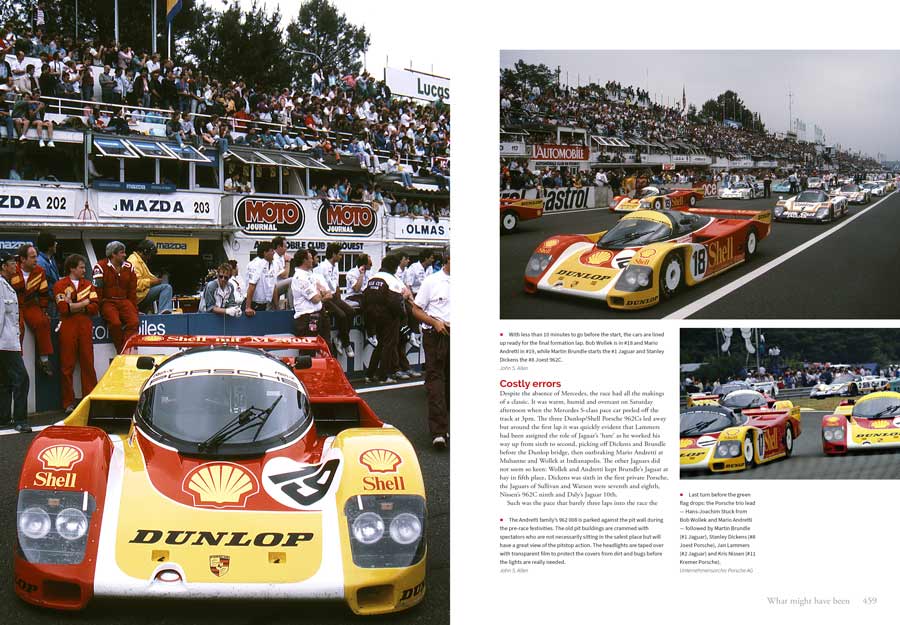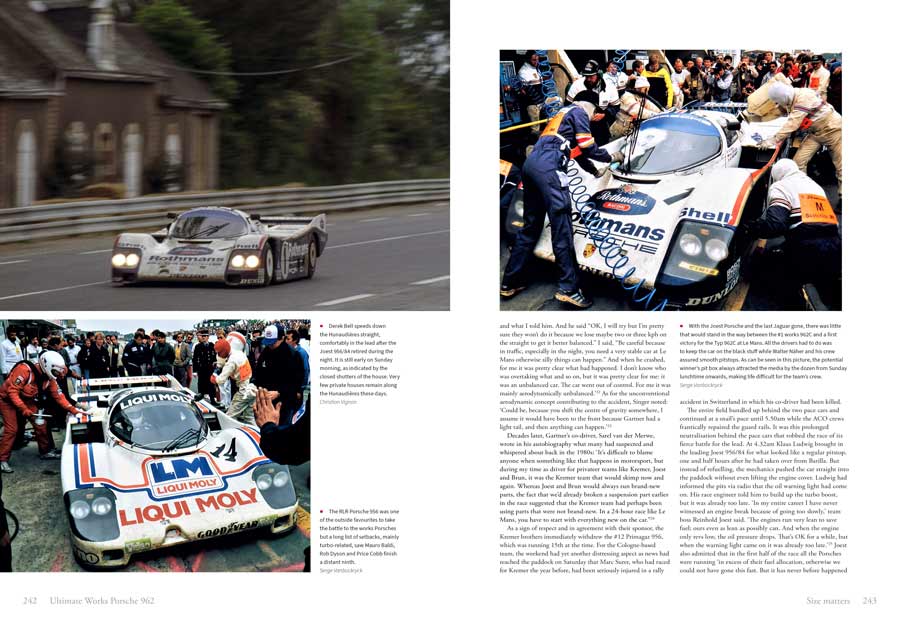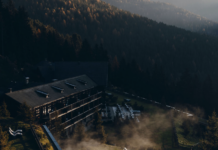The Porsche 962, created in 1984, was the successor to the all-conquering Group C-specification Porsche 956 of 1982, but also very much the result of Porsche adapting its successful Group C car to the needs and regulations of the US-based IMSA GTP Championship. The 962 proceeded to obliterate the competition on both sides of the Atlantic, making it the most successful purpose-built race car in automotive history.
This three-volume book outlines in unprecedented detail the ten-year career of the works Porsche 962s and 962Cs, built and entered by the Weissach-based factory team run by Peter Falk and Norbert Singer, and driven to multiple victories by the likes of Jacky Ickx, Derek Bell, Jochen Mass, Hans-Joachim Stuck, Al Holbert, Hurley Haywood and many others.
Click here for further information
Fifth in the Ultimate series from Porter Press
- It’s all about politics: a detailed account of the lengthy negotiations between Porsche and the International Motor Sport Association on how to allow or adapt the 956 for the American Camel GT Championship, including the notes and quotes of those representing both parties at the numerous meetings on both sides of the Atlantic.
- The best for both worlds: the rapid design and development of the 962 under the guiding hand of technical guru Norbert Singer created yet another motorsport milestone for Porsche – and the world of sportscar racing. Published here for the first time are dozens of unique photos of wind tunnel tests and specially commissioned artwork showing versions of the 962 that never went beyond the drawing board.
- Volume 1 moves on to cover the 1984–88 period (the works years): race-by-race chapters explain in exhaustive detail the activities of the Porsches works team, starting with the one-off IMSA race in 1984 that gave the 962 its baptism of fire.
- The 1985–87 world championship campaigns with the famous Rothmans Porsches brought victory at Le Mans in 1986 and 1987 and championship titles for Derek Bell and Hans-Joachim Stuck in 1985 and 1986. Every event is covered in great detail, including all the technical developments that were tried and tested between races, the strategies used, the successes savoured, the odd defeat explained.
- A rather super cup: for the first time since the German national sportscar championship was created back in 1972, Porsche entered a works team in the 1986 ADAC Supercup. Hans-Joachim Stuck’s special lightweight 962C with its trick PDK transmission initially dominated the series but later met with fierce competition from the many privateer Porsche teams and also the works Mercedes team. Every race of the four-year existence of the Supercup is covered, including how in 1987 the creation of Porsche’s iconic asymmetric Shell/Dunlop livery came about.
- Volume 2 examines the ‘Joest’ years (1989–94): following the works Rothmans Porsche team’s unexpected withdrawal from the World Sports-Prototype Championship after yet another Le Mans win in 1987, the world of sportscar racing was at a loss. The works team made a one-off comeback to Le Mans in 1988 and almost won, then gave an ultimate encore performance at Fuji at the end of that same year before closing its doors seemingly for good to concentrate on IndyCar and F1. But a little back door was kept open and earlier developments of what should have been the 962/88 were passed on to Reinhold Joest, the most successful privateer Porsche team owner. Joest promptly beat the Mercedes at Dijon in 1989 – scoring the 956/962’s 39th and final world championship victory – and was in the running for the title for most of the year, prompting Porsche to relaunch its Group C programme the following season.
- The second volume covers all activities with the works and works-supported 962Cs, in the ADAC Supercup of 1989 as well as in the WS-PC, where Joest became the de facto works team in 1990. With the demise of the ‘fuel formula’ at the end of 1990, Joest took his works cars to the IMSA and Interserie championships, again with much success.
- Le Mans 1994 marked the final appearance of a works 962, as a road-homologated GT car. Once again technical director Norbert Singer showed that he could read the technical regulations better than those who had written them, instigating the peculiar ploy of converting the 962C to a road car and back to a race car, and promptly won Le Mans again.
- Volume 3 covers the cars and the people. All 19 works chassis (16 Porsche 962s and three Dauer 962 LM GTs) are outlined in exhaustive technical detail, recording every test and every race with all available data, from gear ratios and fuel consumption figures to strategies and pitstop times. All this information has been gathered by the author from sifting through thousands of pages of period documents in Porsche’s Stuttgart archives and conducting dozens of interviews with people significant to the 962 story. Also included is the ownership history of each of the cars after completion of their race careers, with photos of where they are now.
- Artwork: exclusively commissioned artwork depicts every single chassis as it ran, as well as the aerodynamic evolution of the 962 throughout the years and some of the peculiar wind tunnel test models that never saw the light of day.
- Restoration: the ground-up restoration of three of the works 962Cs is covered in detail through many pages of step-by-step photos.
- Exclusive photography: eight of the cars are the subject of eye-catching multi-page photoshoots by some of the world’s finest automotive photographers.
- The people: detailed biographies of the two key engineers behind the 962 and all those who raced the works cars: Peter Falk, Norbert Singer, Jacky Ickx, Derek Bell, Jochen Mass, Vern Schuppan, Al Holbert, Hurley Haywood, Hans-Joachim Stuck, John Watson, Bob Wollek, Henri Pescarolo, Drake Olson, Kees Nierop, Price Cobb, Klaus Ludwig, Mario Andretti, Michael Andretti, John Andretti, Sarel van der Merwe, Yannick Dalmas, Thierry Boutsen, Mauro Baldi and Danny Sullivan.
About the author
Serge Vanbockryck began his career as a journalist and photographer in the late 1980s, covering sportscar and endurance racing for newspapers and magazines in the Netherlands, France, Germany and the UK, while also working for radio and television in Belgium, France and the UK. He has been a photographic contributor to many of the ACO Le Mans yearbooks, to Dr János Wimpffen’s sportscar tetralogy that accompanied his epic book Time And Two Seats, and to Jean-Marc Teissèdre’s biography of Bob Wollek. He is a regular contributor to British monthly Racecar Engineering and to Germany’s leading automotive monthly Sport Auto, as well as being the co-author of the official Porsche Rennsport Reunion programmes. He is a member of The Society of Automotive Historians in Britain.
Since the late 1980s he has been studying, documenting and gathering all possible racing and test data on the 200+ Porsche 956s and 962s – and their derivatives – built by Porsche, its subcontractors and many private constructors on both sides of the Atlantic, and raced in period competition from 1982 until 1999, with the clear purpose of one day writing the ultimate book of reference on this most iconic of race cars. His dozens of interviews with key decision makers at Porsche, and also with engineers, managers and drivers from the works team as well as the many privateer teams, and his several hundreds of hours spent researching every conceivable period document at Porsche’s historical archives in Stuttgart, have over time made him one of the world’s foremost historians on the subject.
Professionally, he left journalism for public relations and marketing in the mid-1990s, working in F1 and the World Rally Championship with Marlboro and Lucky Strike, and Le Mans and the WRC when Toyota returned to international motorsport with the Corolla WRC and André de Cortanze’s phenomenal GT-One. Since 2000 he has been involved with General Motors’ international motorsport activities as European PR coordinator for the Cadillac LMP, Corvette GT and Chevrolet WTCC programmes. In 2019 he received the international ACO/UJSF Communications Award for his work with Corvette Racing.
This book is his second title for Porter Press’s Ultimate Series, following up on the critically acclaimed Ultimate Works Porsche 956 – The Definitive History, published in 2019.
About Porter Press
Porter Press International is renowned for publishing top-quality motoring books. Founded in 2005 by acclaimed automotive author Philip Porter, the company is now firmly established worldwide as a leading motoring publisher.
The unrivalled Porter Press team includes James Page, former editor of Classic & Sports Car and Steve Rendle, former commissioning editor for Haynes Publishing. Both liaise closely with chief design contributor, Martin Port, former art editor of Classic & Sports Car.
Porter Press is proud to have worked with a number of motoring icons, including Murray Walker, Martin Brundle, Derek Bell, Gordon Murrray, Michael Turner and Stirling Moss.
Authors include Doug Nye, Ian Wagstaff, Keith Bluemel, James Page, Mick Walsh, Chas Parker, Rinsey Mills, J. Mac Hulbert, Richard Heseltine, Matthew Field, Malcolm McKay, Gordon Bruce, Mark Cole, Michael Kliebenstein, Serge Vanbockryck and Philip Porter.
more information: porterpress.co.uk

